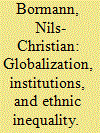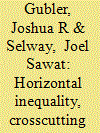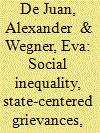|
|
|
Sort Order |
|
|
|
Items / Page
|
|
|
|
|
|
|
| Srl | Item |
| 1 |
ID:
164163


|
|
|
|
|
| Summary/Abstract |
Do different types of inequality spur violence with different targets? This article explores whom violent movements choose to target when they take to arms, by comparing civil conflicts, which target the state, to communal conflicts, which target other ethnic groups. Different types of ethnic group disadvantage relate to conflict through different mechanisms. Political exclusion is expected to promote the choice to target the central government rather than other ethnic groups, while economic disadvantages should increase the risk of both civil and communal conflicts. The different expectations stem from two important differences between political and economic horizontal inequalities: only the government has the authority to change the political distribution, while there can be many avenues to economic redistribution; and blame is more straightforwardly assigned to the government for political than for economic disadvantages. Statistical analysis of 155 politically relevant ethnic groups in Africa (1991–2009) provides support for both propositions.
|
|
|
|
|
|
|
|
|
|
|
|
|
|
|
|
| 2 |
ID:
179862


|
|
|
|
|
| Summary/Abstract |
Recent research has shown that inequality between ethnic groups is strongly driven by politics, where powerful groups and elites channel the state's resources toward their constituencies. Most of the existing literature assumes that these politically induced inequalities are static and rarely change over time. We challenge this claim and argue that economic globalization and domestic institutions interact in shaping inequality between groups. In weakly institutionalized states, gains from trade primarily accrue to political insiders and their co-ethnics. By contrast, politically excluded groups gain ground where a capable and meritocratic state apparatus governs trade liberalization. Using nighttime luminosity data from 1992 to 2012 and a global sample of ethnic groups, we show that the gap between politically marginalized groups and their included counterparts has narrowed over time while economic globalization progressed at a steady pace. Our quantitative analysis and four qualitative case narratives show, however, that increasing trade openness is associated with economic gains accruing to excluded groups in only institutionally strong states, as predicted by our theoretical argument. In contrast, the economic gap between ethnopolitical insiders and outsiders remains constant or even widens in weakly institutionalized countries.
|
|
|
|
|
|
|
|
|
|
|
|
|
|
|
|
| 3 |
ID:
175715


|
|
|
|
|
| Summary/Abstract |
In 2014 and then again in 2015-16 in Jerusalem, some Palestinians attacked Israelis and others, including through stabbings and vehicular attacks. A case study of Israeli rule of Palestinians in Jerusalem highlights the causal role of horizontal inequality or inter-group disparities in cultural, economic, political, and social realms. Palestinians are shortchanged in each realm, and this helps fuel the violence in the city. The case also adds further nuance to some of the supporting arguments put forward by scholars in the horizontal inequality tradition. Miodownik & Nir’s focus on perceptions suggests the possibility of a gap between reality and perceptions, but in East Jerusalem, Israeli policy and Palestinian perceptions appear in synch. The spontaneous grassroots violence with only limited organizational support contrasts with other cases where violence was the result of the interaction between elites influenced by political inequality and masses motivated by economic inequality. Lastly, Stewart’s policy recommendation of more aid to reduce economic inequality assumes that the rulers will provide more aid or allow others to do so. In East Jerusalem, Israel has not provided sufficient resources but also has blocked the most likely substitute, the Palestinian Authority, from freely operating in East Jerusalem.
|
|
|
|
|
|
|
|
|
|
|
|
|
|
|
|
| 4 |
ID:
113821


|
|
|
|
|
| Publication |
2012.
|
| Summary/Abstract |
In this article, the authors bring together research on horizontal inequality, geographic dispersion of ethnic groups and crosscutting cleavages to present a more holistic theory of ethnic structure and civil war onset. The authors argue that rebel leaders are thwarted in their mobilization efforts in highly crosscutting societies due to a lower probability of potential combatants identifying with nationalist goals, decreased ability to exert social control, and diminished in-group communication. Using cross-national data from over 100 countries, the authors provide evidence that civil war onset is an average of nearly twelve times less probable in societies where ethnicity is crosscut by socioeconomic class, geographic region, and religion.
|
|
|
|
|
|
|
|
|
|
|
|
|
|
|
|
| 5 |
ID:
163432


|
|
|
|
|
| Summary/Abstract |
What role does horizontal social inequality play for political protest in middle-income countries? We argue that public social service provision is an important driver of state perceptions. When a state fails to deliver services in an equitable manner, trust in institutions erodes and protest becomes more likely. We use a mixed methods design to investigate this argument in South Africa. First, we combine police event records with census data to estimate correlations between service inequality and protests. Second, we draw on an opinion survey with 27,000 respondents to investigate the suggested mechanism linking social inequality to protest through political attitudes. Third, we focus on qualitative protest accounts in two areas identified by a matching approach to assess the plausibility of our quantitative findings. Throughout these analyses, we document a robust association between horizontal social inequality and protest.
|
|
|
|
|
|
|
|
|
|
|
|
|
|
|
|
|
|
|
|
|